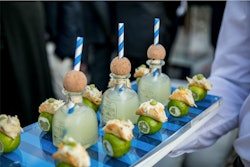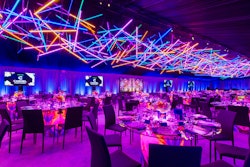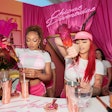
While best practices for Instagram are well documented, the rules can be a bit different for event planners, designers, and other industry pros. To navigate this, BizBash spoke to some top producers and marketing consultants about how they use the social media app, learning their rules for stories versus posts, tagging vendors, posting personal content, and more. Here's what they had to say.
1. Stories are a chance to showcase frequent behind-the-scenes content.
Earlier this year, Instagram announced that its stories feature is now being used by a whopping 500 million people daily. This creates a unique opening for event producers.
"Stories are great for more casual [content], more of the process of what we do," explains Cara Kleinhaut, partner and C.E.O. of New York and Los Angeles-based experiential firm AGENC Experiential & Digital (@weareagenc). Her team, for example, uses stories to share event set-up photos and videos, site visits, office celebrations, and other personal content. "It allows followers to get a better sense of who we are as people and our culture,” she says.
Another benefit of stories: more frequent posts in real time, notes marketing consultant Channing Muller, founder of Chattanooga, Tennessee-based firm DCM Communications (@dcmcommunications) and previously a contributing editor at BizBash.
“Stories are great for behind-the-scenes at an event, when you really can't wait to share more than one thing as the event progresses and/or when you can't capture the right angle/lighting but the content is good,” she explains.
Stories are also a place when event pros can talk directly to their followers, such as providing a personal tour of the event set-up. “They only last for 24 hours, and can give your account a personal human touch,” says Valerie Bihet, owner of the Vibe Agency (@thevibeagency) in Miami. “Put yourself out there. Showing your face will help build a solid network of followers.”
Another thing to keep in mind is that stories tend to get a higher viewership than main feed posts, says Kleinhaut, who notes that geotagging, using hashtags, and asking questions are all good options in this format. Gifs and stickers can also be a fun addition. "It's a great way to keep our followers engaged on a daily basis,” she notes.
2. Choose your main feed posts carefully—and make sure you have client approval.
The main feed, on the other hand, should function as a more polished portfolio of sorts. Muller recommends only posting here once per day, or even just a few times per week. "You don't want to dominate someone's news feed to the point that it's annoying and they unfollow," she says. "[So] those photos need to be the show stoppers."
Kleinhaut suggests that images and captions in the main feed be approved by clients to ensure they fit any branding guidelines. "This is very important and appreciated by clients," she explains. "Often there are events we are not allowed to post from until after the event is over, and there are specific aspects that are not to be posted about.
“It's important that vendors check with us before posting as well, to be sure they are in alignment with any agreements we have made with the client about posting,” she adds.
Once the event has started and guests begin posting their own pictures, clients are normally fine with Instagram posts, notes Kleinhaut. Just make sure to use the official event hashtag—and remember to always tag the client.
"We also like giving the story not just on what we did or created—but what was the purpose of the event?" she explains. "Why did the client host this experience? What are they trying to accomplish? We want our post to support the overall goal and purpose of the night.”
3. Credit your team.
In addition to tagging a client, many event pros like to credit the main vendors involved in an event. "And tag their accounts," says Muller. "This will increase the chances of them reposting and/or commenting on the post, which also helps boost your visibility."
And since these main-feed posts are more likely to be professional images rather than phone shots, be sure to tag the photographer, notes Kleinhaut.
Bihet, though, cautions against giving too much information about every vendor you worked with. "You don't want your clients to contact them directly and forget about you," she says.
4. Use hashtags, and pay attention to what time you’re posting.
Hashtags can help attract new followers. In addition to official event hashtags—see our story on creative ways to promote these—popular industry hashtags include #eventprofs, #eventdesign, and, of course, #bizbash. A convenient feature: If you start typing a hashtag in a caption or comment, Instagram will tell you how many posts use that language. #eventplanner, for instance, has more than 6 million posts, while #eventplanning has 2.4 million.
As for timing, studies show that best practices vary depending on the industry. A recent study from social media management platform Hootsuite noted the best days and times for posts from the media and entertainment industry, food and beverage industry, tourism industry, and more. Checking your Instagram analytics can also inform these decisions.
5. Personal posts can be okay—when done carefully.
If you're short on content, or just starting to cultivate a following, it's fine to post images of other people's work. “This is a great way for new pros who don't have a huge portfolio to remain active on Instagram,” says Muller. “[But] the key is never to take credit to imply that you did the work.”
When possible, tag the vendors who did do the work—and always credit the original photographer and account you grabbed the image from. “When in doubt, ask if you can repost before you do to avoid any potential copyright issues,” suggests Muller. “Super big accounts may not reply, but at least you've done your due diligence.”
As for posts that show an event pro’s personal life, opinions are mixed. "For me, at one point I had to develop my personal account as the business represents so much more than just me as the owner," says Kleinhaut, who runs a team of 40 employees in multiple cities. "So to mix it does limit the growth of the company a bit; the Instagram feed of AGENC represents everyone who works there."
Bihet agrees. “Work and personal life should be kept apart on social media,” she says. “Your professional account is made to showcase your work, not share pictures of your life. It might play against you and take down your credibility.”
Muller, though, argues that for smaller firms and independent contractors, there's a way to get personal. “If you are a wedding planner, I don't need to see a picture of your kid eating a cupcake on the weekend. That's not why I follow you,” she explains. “However, a pic of you or your team working on an event interspersed with pictures of your actual work? That has a place. It adds a face to the brand and personalizes it without it being personal.”
6. If you have the means, invest in a social media team.
Kleinhaut emphasizes the importance of having someone on the team dedicated to social media. "Ninety percent of our incoming inquiries come through Instagram," she notes. "What we put on that feed and how we tell our story is crucial for our business."
For smaller budgets, Muller says the decision depends on the company’s goals for social media. “Do you want to just get more brand awareness or use it as a lead generator?” she asks. “The latter requires a lot more time, strategy, and content creation, which could be outsourced to a dedicated social person.”
But, Muller continues, teams should weigh social media against other marketing expenses. “Social media is great, but if you could upgrade your website, run some ads, and/or attend a handful of networking events or trade shows for the same price as hiring an outside firm to manage your social, then there are better ways to spend your money.”
7. And yes, you should read the comments.
"Be real. Be authentic. Ask questions. Answer all your comments," says Kleinhaut. "Social media is a two-way conversation, not a one-way broadcast.”
Make sure to check out our previous lists of event pros, designers, and wedding planners to follow on Instagram—and keep an eye on bizbash.com this summer for fresh lists of our favorite accounts. (And you can follow us at @BizBash.)



















